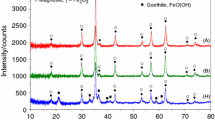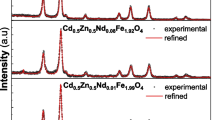Abstract
The ionic conductivities of several samples in the Sc2O3-ZrO2 system (Sc2O3: ∼ 8 mol %) have been measured using 4-probe d.c. and 2-probe complex impedance dispersion techniques. Samples which contained monoclinic zirconia showed hysteresis effects and S-shaped Arrhenius conductivity plots. This behaviour was assigned to the m-ZrO2 ⇌ t-ZrO2 transformation. In samples which were free of monoclinic ZrO2, contributions from the grain boundary resistance were relatively small. The Arrhenius plots of their conductivity showed a distinct change in the slope around 600° C towards higher activation energy and this was attributed to vacancy trapping. The 4-probe d.c. data could be fitted to an equation of the formρ=A 1 T exp (E 1/RT)+A 2 T exp (E 2/RT). The process which dominated the conduction mechanism at lower temperatures had an activation energy of 130 to 140 kJ mol−1. The activation energy for the migration of oxygen ion vacancies within the bulk of the grain was 64 to 70 kJ mol−1.
Similar content being viewed by others
References
H. Obayashi andT. Kudo, in “Solid State Chemistry of Energy Conversion and Storage”, Advances in Chemistry Series, Vol. 163, edited by J. B. Goodenough and M. S. Whittingham (American Chemical Society, Washington, DC, 1977) p. 316.
W. Doenitz andR. Schmidberger,Int. J. Hydrogen Energy 7 (1982) 321.
“Measurement of Oxygen, Proceedings of the Interdisciplinary Symposium”, edited by H. Degn, I. Balslev and R. Brook (Elsevier, Amsterdam, 1976).
“Advances in Ceramics”, Vol. 3, edited by A. H. Heuer and L. W. Hobbs (American Ceramic Society Inc., Columbus, Ohio, 1981).
J. E. Bauerle,J. Phys. Chem. Solids 30 (1969) 2657.
T. M. Gur, I. D. Raistrick andR. A. Huggins,Mater. Sci. Eng. 46 (1980) 53.
F. M. Spiridonov, L. N. Popova andR. Ya. Popil'skii,J. Solid State Chem. 2 (1970) 430.
D. W. Stricker andW. G. Carlson,J. Amer. Ceram. Soc. 48 (1965) 286.
J. Lefèvre,Rev. Hautes Temp. Refrac. 1 (1964) 229.
M. R. Thornber, D. J. M. Bevan andE. Summerville,J. Solid State Chem. 1 (1970) 545.
E. Summerville, PhD thesis, The Flinders University of South Australia (1973).
L. S. Alekseenko, A. M. Gavrish, N. V. Gul'ko, G. P. Orekhova, L. A. Tarasova andN. K. Polnitskaya,Russ. J. Inorg. Chem. 26 (1981) 476.
Z. S. Volchenkova andV. M. Nedopekin,Izv Akad. Nauk SSSR Neorg. Mater. 10 (1974) 1821.
R. C. Garvie andP. S. Nicholson,J. Amer. Ceram. Soc. 55 (1972) 303.
H. G. Scott,J. Mater. Sci. 10 (1975) 1527.
M. J. Bannister andP. F. Skilton,J. Mater. Sci. Lett. accepted.
P. F. Skilton, CSIRO, Division of Materials Science, Internai Report No. AML-82-22.
J. E. Bauerle andJ. Hrizo,J. Phys. Chem. Solids 30 (1969) 565.
Da Yu Wang andA. S. Nowick,J. Solid State Chem. 35 (1980) 325.
S. H. Chu andM. A. Seitz,ibid. 23 (1978) 297.
A. I. Ioffe, M. V. Inozemtsev, A. S. Lipilin, M. V. Perfilev andS. V. Karpachov,Phys. Status Solidi A 30 (1975) 87.
R. E. W. Casselton,ibid. 2 (1970) 571.
J. A. Kilner andR. J. Brook,Solid State Ionics 6 (1982) 237.
J. A. Kilner andC. D. Waters,ibid. 6 (1982) 253.
M. J. Verkerk, B. J. Middelhuis andA. J. Burggraaf,ibid. 6 (1982) 159.
Author information
Authors and Affiliations
Rights and permissions
About this article
Cite this article
Badwal, S.P.S. Electrical conductivity of Sc2O3-ZrO2 compositions by 4-probe d.c. and 2-probe complex impedance techniques. J Mater Sci 18, 3117–3127 (1983). https://doi.org/10.1007/BF00700796
Received:
Accepted:
Issue Date:
DOI: https://doi.org/10.1007/BF00700796




